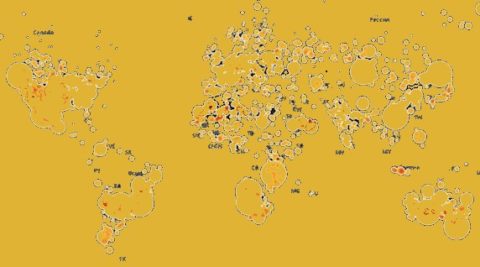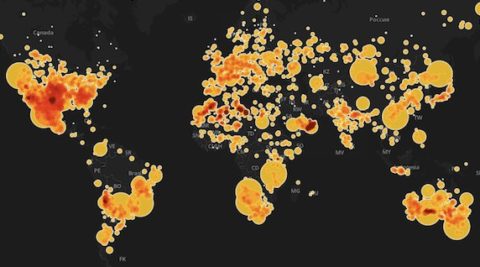As is obvious within a few seconds of having tweeted the map purportedly showing “every meteorite that has hit Earth since 2300 BC”, the map actually just shows where the people are and where people have recorded meteorite impacts.
The first comment on the Gizmodo item puts this quite succinctly”. It’s all the recorded meteorites. Not every meteorite. There’s a big difference. The data would skew very heavily to places where there was been human habitation, followed by exploration and cartography, and filtered for places like the Sahara and the ocean, where shifting terrain masks any prior impact site. In all, this would be a tiny sample of all the meteorites from the past 4312 years.”
In fact, statistically a meteorite is almost as likely to hit any spot on the Earth’s surface as any other, including the oceans and so the map would really look more like this:

Presumably, the original map was generated to highlight the risk we face from incoming solar system shrapnel, especially in the wake of the recent Russian impact on the same day as an asteroid made a rather worryingly close flyby. Â One might even go so far as to say that it was somewhat sensationalist, scaremongering, even. It seems that humanity has a fixation on doomsday prophecies from the ancient god-given plagues, pestilence and thunderbolts from the blue, hell, devils, demons and ghosts and more recently alien invasions and nuclear war (that perhaps is a real threat) and even the Y2K bug (remember that?) and cyber war. Given that all of those those have generally turned out to be nothing but fantasy (with the exception of actual plagues) perhaps a cosmic collision is just the latest in a long line of unwarranted worries.
I can say that at least until a rather bigger chunk of rock hits a major city and triggers an unsupernatural armageddon. There are, after all, an estimated 100,000 to 1,000,000 chunks of rock flying around the sun that cross Earth’s orbit right now that we have never observed, but many more are flung in from the far-reaching corners of the solar system by the enormous gravitational fields of the gas giants Jupiter and (to a lesser extent) Saturn. Conversely, it may be that Jupiter actually protects us from debris. We might stand a chance of spotting an incoming asteroid with maybe three weeks to spare…would that be sufficient time for us to make a contingency plan, to hide under the bed or blast the rock apart?
